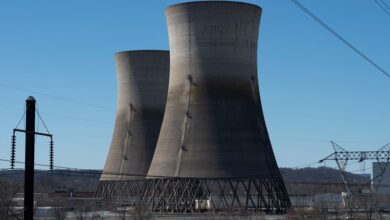
A group of scientists say that if you looked up from Earth approximately 466 million years ago, you would probably have seen a bright ring stretching across the sky. The hypothesized ring of the earth, with a lifespan of only a few tens of millions of years, did not last long on a cosmic scale; But apparently it was persistent enough to have a lasting impact on the planet’s geological record.
A study recently published in the journal Earth and Planetary Sciences links the increase in the number of impact craters during the Ordovician, the period before land animals lived, to a ring made of asteroid debris that surrounded Earth millions of years ago.
Scientists have long speculated about the origin of Ordovician meteorite events. During that time, the Earth was bombarded by space rocks at an unusually high rate, and the surface of the planet was covered with a large number of impact craters. Previous researches attributed these craters to a large asteroid that disintegrated in the main belt between Mars and Jupiter and bombarded Earth by sending its rocky fragments into the inner solar system.
The formation of the Earth’s rings is probably related to significant changes in the planet’s climate and biodiversity
But what would happen if that ancient body broke apart in our planet’s sky? The researchers, led by Andy Tomkins, a researcher in Earth and Planetary Sciences at Monash University in Australia, imagined an asteroid that passed thousands of kilometers from Earth and came close enough to be torn apart by the planet’s gravity. The debris from the asteroid’s collapse then coalesced into a ring around the equator. According to scientists, this scenario is probably related to significant changes in the climate and biodiversity of the planet at that time.
“The idea came to me when I read a famous scientific paper about the formation of Phobos and Didymus, the moons around Mars, from pieces of the ring around the Red Planet,” says Dr. Tomkins. This made me think that if the Earth was also ringed in the past, how would its effects appear in the geological record of the planet.”
If the asteroid debris came from the asteroid belt, the craters should have spread across the planet; But the researchers mapped 21 Ordovician-era craters and found that all of them are within 30 degrees of the equator. Of course, this finding was not revealed quickly; Because during the Ordovician period, the Earth’s continents were all part of a supercontinent called Gondwana. Consequently, the concentration of craters around the equator suggests that they were formed by meteorites that fell through the equatorial ring.
The research team argues that there is still no evidence that Mars and the Moon experienced an increase in impact craters during that time; As a result, the remnants of asteroids were concentrated around the Earth. In addition, researchers point to Ordovician meteorites from Sweden that show little exposure to cosmic rays; This means that the rocks fell to the earth during tens of thousands of years after disintegrating from their parent body. On the other hand, the remnants of the asteroid belt are usually exposed to space radiation for millions of years.
The researchers also wondered if the shadow cast by the ring on Earth had cooled the planet, triggering a major ice age known as the Hirnantian Ice Age. According to scientists, that cold age changed the path of life on earth. Dr Tomkins says this connection is largely speculative and needs further study.
Gretchen Bendix, a professor of Earth and Planetary Sciences at Curtin University in Australia, finds the researchers’ study exciting, but at the same time inconclusive and based on many assumptions. He points out that meteorites may have fallen far from the equator without leaving any lasting geological traces. He is also skeptical of the proposed connection between the Ring and the Hirnantian Ice Age.
Dr. Tomkins and his colleagues have outlined methods to test their hypothesis; including the study of Ordovician meteorites at different latitudes and more complex models of how a ring around Earth formed from a collapsing asteroid.
In any case, for now, the idea of an ancient Earth ringed almost entirely with inhabited sea creatures and the remains of a collapsed space rock is fascinating.









